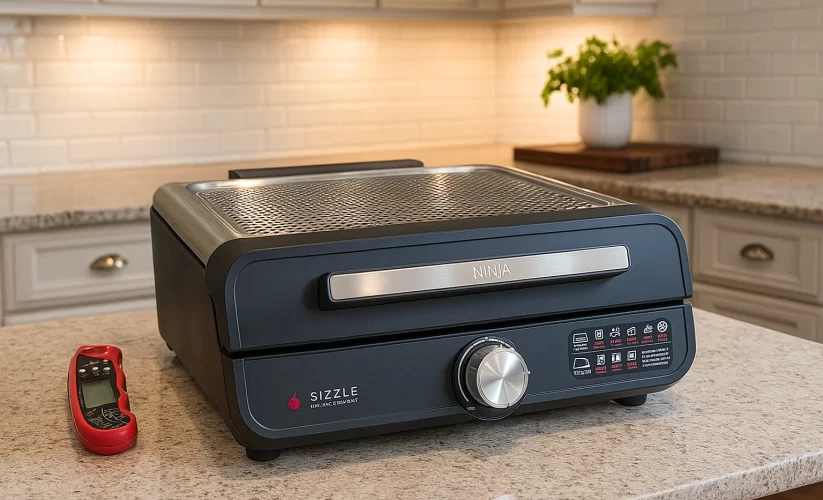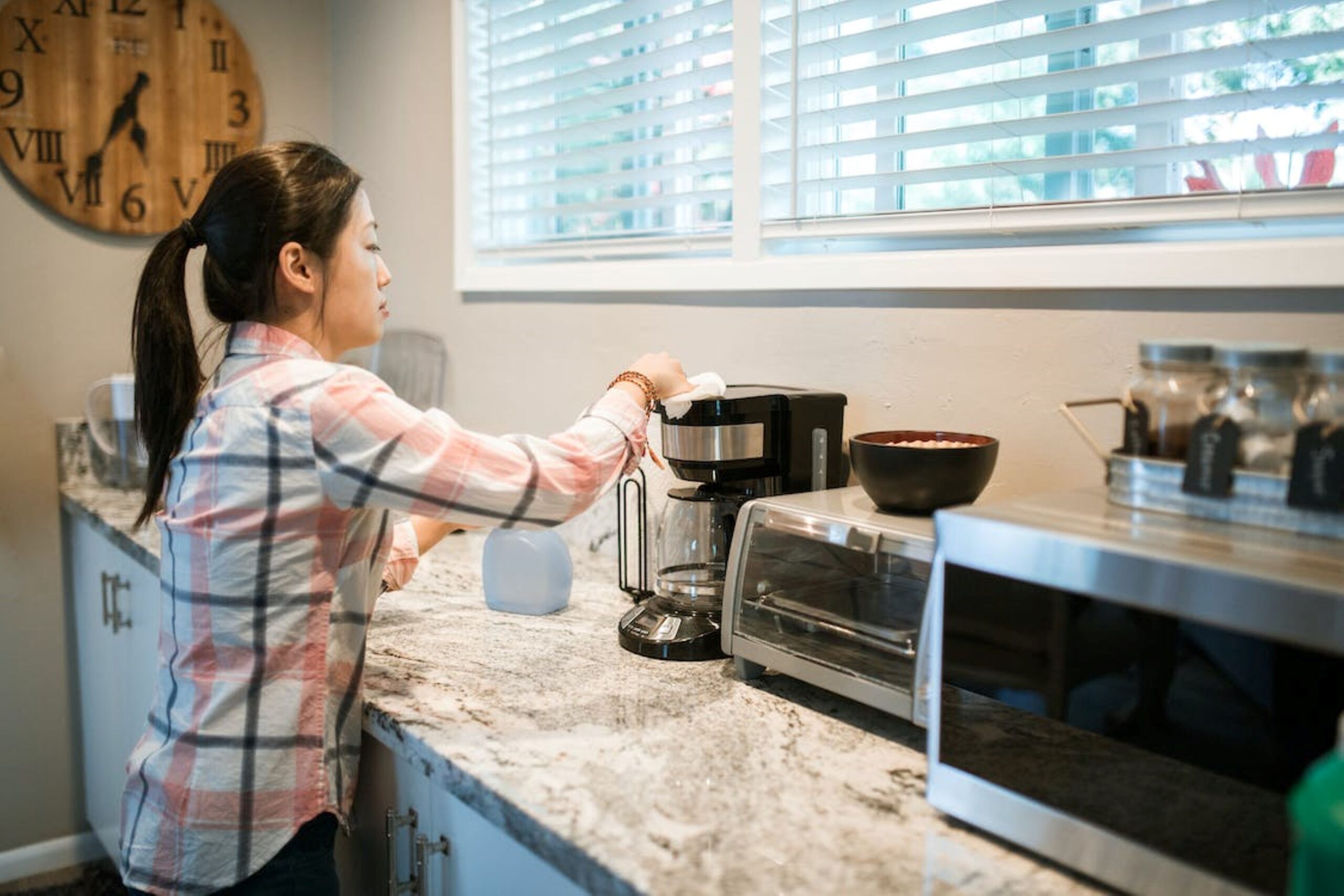
Ninja Griddle and Indoor Grill Review
The sizzle of perfectly seared vegetables, the aroma of grilled chicken wafting through the kitchen, and the satisfaction of restaurant-quality grill marks—all achieved indoors, regardless of the weather outside. For those who’ve struggled with inconsistent stovetop cooking or longed for grilled flavors without the hassle of outdoor grilling, the journey to discovering indoor grilling solutions has been transformative.
“Indoor grilling technology has revolutionized home cooking by bringing outdoor flavors inside while offering unprecedented convenience and control.”
— Cook’s Illustrated Kitchen Equipment Review
Key Takeaways
- Versatile cooking options: Indoor grills and griddles offer multiple cooking methods in one appliance, from grilling and griddling to air frying
- Year-round convenience: No weather dependency means enjoying grilled favorites any season
- Healthier cooking: Advanced technology reduces oil usage while maintaining flavor and texture
- Space-efficient: Compact designs fit various kitchen sizes without sacrificing cooking surface
- Easy maintenance: Non-stick surfaces and removable components simplify cleanup
- INTERCHANGEABLE GRILL & GRIDDLE PLATES: From char-grilled strip steaks to sizzling fajita veggies, unlock delicious flavors any time of the day using the interchangeable grill and griddle plates.
- 500°F MAX HEAT: Reach temperatures of up to 500°F for high-heat grilling and searing and get better char-grilled marks right from your kitchen. (vs. PowerXL Smokeless Grill Elite).
- EDGE-TO-EDGE COOKING: No hot spots. No cold spots. Just even, edge-to-edge heating for perfectly cooked dishes every time.
- INTERCHANGEABLE GRILL and GRIDDLE PLATES: From char grilled strip steaks to sizzling fajita veggies, unlock delicious flavors any time of the day using the interchangeable grill and griddle plates.
- 500°F MAX HEAT: Reach temperatures of up to 500°F for high heat grilling and searing and get better char grilled marks right from your kitchen. (vs. PowerXL Smokeless Grill Elite)
- EDGE TO EDGE COOKING: No hot spots. No cold spots. Just even, edge to edge heating for perfectly cooked dishes every time.
The Journey to Indoor Grilling Mastery
Picture this: standing in front of a stovetop, attempting to recreate that perfect grilled taste, only to end up with unevenly cooked food and a smoke-filled kitchen. This frustration leads many to explore indoor grilling solutions, seeking that elusive combination of convenience, flavor, and consistency.
The transformation begins with understanding what makes indoor grilling different from traditional methods. Unlike conventional stovetops that heat from below or outdoor grills that require weather cooperation, modern indoor grills and griddles utilize advanced heating technology to deliver restaurant-quality results in any kitchen, any time of year.
Understanding the Power of Indoor Grilling Technology
The Science Behind Consistent Results
Indoor grills have evolved dramatically from their early counterparts. Today’s models, particularly the Ninja griddle and indoor grill series, incorporate cyclonic air circulation and precision temperature controls. This technology creates consistent heat distribution across the entire cooking surface, eliminating frustrating cold spots that lead to uneven cooking.
The transformation happens at multiple levels. The heating elements work in concert with airflow systems, creating an environment where proteins develop that coveted caramelized exterior while remaining tender inside. Vegetables achieve char without becoming mushy. Even delicate fish maintains its integrity while gaining beautiful grill marks.
Breaking Through Common Barriers
Many home cooks face similar obstacles when transitioning to indoor grilling:
The smoke concern: Traditional indoor grilling often meant setting off smoke alarms and ventilating the entire house. Modern smokeless technology addresses this by controlling cooking temperatures and incorporating efficient air circulation systems. The result? Authentic grilled flavor without the smoke that sends everyone scrambling to open windows.
Temperature uncertainty: Unlike outdoor grills where heat levels fluctuate with wind and weather, indoor grills provide precise temperature control. Built-in thermometers and smart cooking systems remove guesswork, ensuring proteins reach safe temperatures while maintaining optimal texture.
Limited cooking surface: Early indoor grills offered minimal space, forcing cooks to prepare meals in multiple batches. Contemporary designs maximize cooking area without overwhelming counter space. Split-zone cooking capabilities even allow simultaneous preparation of foods requiring different temperatures.
Cleanup challenges: The thought of scrubbing stuck-on food from grill grates has deterred many from regular grilling. Ceramic-coated surfaces and removable components have transformed cleanup from a dreaded chore into a simple task. Most parts are dishwasher-safe, returning to ready-to-use condition with minimal effort.
The Emotional Connection to Cooking Transformation
From Frustration to Confidence
The journey with indoor grilling equipment often begins with hesitation. There’s vulnerability in admitting that stovetop cooking isn’t delivering desired results. Questions arise: “Will this actually work?” “Am I wasting money on another kitchen gadget?” “Can I really achieve those flavors at home?”
These doubts dissipate with the first successful meal. The moment when perfectly grilled chicken emerges with crispy skin and juicy interior, or when vegetables develop those restaurant-quality char marks—these victories build cooking confidence that extends beyond just grilling.
Small Wins That Spark Transformation
Success doesn’t require immediately mastering complex recipes. The transformation happens gradually:
- That first morning when crispy bacon and fluffy pancakes cook simultaneously on the griddle surface, saving precious time during busy weekdays
- The satisfaction of preparing vegetables that family members actually enjoy, thanks to the enhanced flavors from proper grilling
- The confidence to invite friends over, knowing that meal preparation won’t keep anyone isolated in the kitchen
- The relief of cooking fish without the lingering odors that traditional methods create
Each small victory reinforces the decision to embrace indoor grilling, building momentum toward more adventurous cooking experiments.
Mastering Different Cooking Scenarios
Weeknight Efficiency
Busy evenings demand quick solutions without sacrificing nutrition or flavor. The griddle function excels here—cooking proteins and vegetables side-by-side while maintaining their distinct flavors. The ability to prepare complete meals in under 30 minutes transforms hectic weeknights from stressful to manageable.
Meal prep becomes more appealing when the process doesn’t feel burdensome. Grilling multiple chicken breasts or preparing a week’s worth of vegetables becomes an almost meditative activity rather than a dreaded task. The even heat distribution ensures consistent results across batches, eliminating the frustration of some pieces being perfect while others are overcooked.
Weekend Cooking Adventures
When time permits deeper culinary exploration, the versatility of multi-function indoor grills shines. The air frying capability transforms frozen foods into crispy treats without deep frying’s mess or calories. Roasting functions handle everything from whole chickens to root vegetables, developing deep, complex flavors.
The dehydrating feature opens entirely new possibilities—creating healthy snacks, preserving garden harvests, or making homemade jerky. These options encourage creativity and experimentation, keeping cooking interesting and engaging rather than routine.
Entertaining With Ease
Hosting guests often brings anxiety about timing multiple dishes and keeping everything warm. Split-zone cooking capabilities address this perfectly. Grilling main courses on one side while keeping sides warm on the other ensures everything reaches the table at optimal temperature.
The impressive presentation of grill-marked foods elevates casual gatherings into memorable occasions. Guests appreciate the thought and effort reflected in professionally prepared dishes, even when the process was surprisingly straightforward.
Addressing Budget and Space Realities
Making Thoughtful Investments
The decision to purchase indoor grilling equipment involves careful consideration. These aren’t impulse purchases but investments in daily life quality. Evaluating cooking frequency, household size, and available counter space helps narrow options to models that genuinely enhance rather than complicate kitchen routines.
Starting with mid-range models often provides the best value. They offer sufficient features for most cooking needs without overwhelming new users with complexity. As confidence grows and cooking styles evolve, upgrading to more advanced models becomes a natural progression rather than a forced decision.
Maximizing Limited Space
Urban apartments and smaller kitchens present unique challenges. Multifunctional appliances become essential, replacing several single-purpose tools. An indoor grill that also air fries and roasts eliminates the need for separate appliances, freeing valuable counter and storage space.
Strategic placement matters. Keeping the grill accessible encourages regular use rather than allowing it to become another abandoned gadget gathering dust in a cabinet. If permanent counter space isn’t available, designating a specific storage spot that’s easily reached ensures the effort to retrieve it doesn’t become a barrier to use.
The Broader Impact on Lifestyle and Wellbeing
Nutritional Transformation
Indoor grilling naturally supports healthier eating patterns. The minimal oil requirements mean enjoying flavorful foods without excessive calories from fats. Vegetables become genuinely appealing when properly grilled—their natural sugars caramelize, creating depth and complexity that boiled or steamed versions lack.
The convenience factor reduces reliance on takeout and processed foods. When preparing healthy meals becomes quick and straightforward, the temptation to order unhealthy options diminishes. This shift impacts not just weight management but overall energy levels and wellbeing.
Mental Health Benefits
There’s unexpected satisfaction in mastering new cooking skills. Each successful meal builds competence and self-efficacy that extends beyond the kitchen. The act of cooking becomes stress relief rather than an additional burden—the focused attention required serves as a form of meditation, providing mental respite from daily pressures.
Sharing homemade meals strengthens relationships. Gathering around food prepared with care creates connection points often missing in busy modern life. These moments of togetherness contribute significantly to emotional wellbeing and family cohesion.
Environmental Consciousness
Indoor grilling consumes less energy than heating full-size ovens, particularly for smaller meals. The efficient heating technology reaches optimal temperature quickly and maintains it with minimal power draw. This efficiency translates to lower utility bills and reduced environmental impact.
The ability to cook fresh ingredients encourages purchasing whole foods rather than packaged convenience items, reducing packaging waste. Growing awareness of food choices often sparks broader environmental consciousness, creating positive ripple effects beyond just cooking methods.
Evolving Expertise and Ongoing Growth
Learning Through Experience
Mastery develops gradually through experimentation and occasional failures. That first over-grilled steak or under-seasoned vegetables provide valuable lessons. Rather than viewing mistakes as failures, they become stepping stones toward understanding how different foods respond to various temperatures and cooking times.
Keeping mental notes (or actual journals) about successful combinations and techniques builds a personalized knowledge base. Discovering that chicken thighs stay juicier than breasts, or that vegetables benefit from light oil coating despite the grill’s non-stick surface—these insights emerge only through hands-on experience.
Expanding Culinary Horizons
Confidence with basic grilling techniques naturally leads to exploring more complex recipes. International cuisines that once seemed intimidating become accessible. Korean BBQ, Mediterranean kebabs, or Japanese teriyaki all become regular dinner options rather than restaurant-exclusive treats.
The willingness to experiment extends to unfamiliar ingredients. That odd-looking vegetable at the farmers market becomes an exciting challenge rather than something to avoid. Indoor grilling’s forgiving nature—with precise temperature control and even heating—reduces the risk of expensive ingredient waste, encouraging adventurous cooking.
Building Community and Sharing Knowledge
Connecting With Fellow Enthusiasts
The journey toward better home cooking often feels isolating, but communities of indoor grilling enthusiasts exist both online and locally. Social media groups dedicated to specific appliance brands provide troubleshooting help, recipe inspiration, and encouragement during learning curves.
Local cooking classes or informal gatherings with friends interested in healthier eating create accountability and motivation. Sharing successes (and disasters) normalizes the learning process and accelerates skill development through collective wisdom.
Contributing to Others’ Journeys
As expertise grows, opportunities arise to help others beginning their indoor grilling adventures. Answering questions in online forums, sharing favorite recipes with neighbors, or simply demonstrating techniques when friends visit—these acts of generosity strengthen communities while reinforcing personal knowledge.
The transformation from struggling beginner to confident cook who helps others represents profound personal growth. This progression illustrates how seemingly simple kitchen equipment can catalyze broader life changes.
Practical Strategies for Long-Term Success
Developing Sustainable Habits
Initial enthusiasm often fades without intentional habit formation. Setting realistic goals helps maintain momentum. Rather than committing to elaborate meals every night, establishing a pattern of using the indoor grill three times weekly creates consistency without overwhelm.
Meal planning reduces decision fatigue that leads to reverting to old patterns. Knowing Wednesday means grilled chicken salads and Friday features fish tacos eliminates the “what’s for dinner” stress that undermines healthy cooking intentions.
Seasonal Adaptations
Cooking needs and preferences shift with seasons. Summer might emphasize fresh vegetables and lighter proteins, while winter calls for heartier roasted dishes. Indoor grilling accommodates these transitions seamlessly, with multi-function capabilities supporting diverse cooking styles year-round.
Taking advantage of seasonal produce keeps meals interesting and cost-effective. The excitement of first-of-season asparagus or peak tomatoes motivates cooking rather than feeling like obligation. Indoor grilling showcases these ingredients beautifully, highlighting their natural flavors without masking them with heavy sauces.
Maintenance and Care
Protecting the investment in quality equipment requires minimal but consistent maintenance. Wiping surfaces after each use prevents buildup that becomes difficult to remove. Periodic deep cleaning according to manufacturer instructions maintains optimal performance and extends appliance lifespan.
Noticing when non-stick surfaces show wear or heating elements seem less efficient allows addressing issues before they become problematic. Most manufacturers offer excellent customer service and replacement parts, making it easy to keep equipment functioning perfectly for years.
Overcoming Skepticism and Doubt
Addressing Common Objections
“It’s just another kitchen gadget” ranks among the most common dismissals. This skepticism often stems from past disappointments with appliances that promised miracles but delivered disappointment. Valid concerns deserve thoughtful consideration rather than defensive reactions.
The difference lies in honest assessment of cooking habits and goals. Someone who rarely cooks won’t suddenly become a chef simply by purchasing equipment. However, for those genuinely interested in improving home cooking but stymied by limitations of traditional methods, indoor grills remove legitimate barriers.
Managing Expectations Realistically
Indoor grilling won’t perfectly replicate outdoor charcoal grilling—that smoky flavor comes from burning wood and dripping fats creating smoke. However, for daily cooking where convenience matters as much as flavor, indoor grills deliver remarkably satisfying results.
Understanding these distinctions prevents disappointment. The goal isn’t replacing cherished summer cookouts but providing viable options for the remaining months when outdoor grilling isn’t practical. Indoor grills excel at their intended purpose without needing to be something they’re not.
The Path Forward
Embracing Imperfection
The journey toward better home cooking isn’t linear. There will be meals that don’t turn out as hoped, times when ordering takeout feels easier, and days when motivation lags. These moments are normal, not failures.
Progress means cooking at home more often than before, not achieving perfection every time. Celebrating this realistic progress rather than holding oneself to impossible standards makes the journey sustainable long-term.
Future Aspirations
As comfort with indoor grilling grows, new possibilities emerge. Perhaps experimenting with homemade marinades and rubs, or exploring fermentation to create unique flavor profiles. Maybe growing herbs specifically for grilling, or trying whole new cuisines previously considered too challenging.
These evolving interests keep cooking engaging and prevent stagnation. The indoor grill that initially seemed like a solution to a specific problem becomes a gateway to broader culinary exploration and personal growth.
Moving Forward With Confidence
The transformation that indoor grilling equipment enables extends far beyond preparing better-tasting food. It represents reclaiming control over nutrition, building valuable skills, and creating moments of connection and satisfaction in daily life.
For those standing at the beginning of this journey—perhaps reading reviews, comparing models, or hesitating before that purchase—know that the decision isn’t really about the appliance itself. It’s about choosing to prioritize health, investing in skill development, and believing that positive change is possible.
The path involves challenges, learning curves, and occasional setbacks. But the destination—confident cooking that nourishes body and soul while fitting seamlessly into real life—makes every step worthwhile. The kitchen becomes a place of creativity and competence rather than stress and limitation.
Whether starting with simple grilled chicken breasts or ambitious multi-course meals, every use of that indoor grill represents progress toward the lifestyle desired. The journey continues, imperfect and individual, but undeniably transformative for those willing to embrace it.
Frequently Asked Questions
What’s the difference between an indoor grill and a griddle?
An indoor grill features raised ridges that create grill marks and allow fat to drip away from food, ideal for meats, vegetables, and foods benefiting from seared appearance. A griddle provides a flat, smooth surface perfect for pancakes, eggs, bacon, and foods requiring even contact with the cooking surface. Many Ninja models offer interchangeable plates, providing both options in one appliance.
Can indoor grills really produce smokeless cooking?
Modern indoor grills with smokeless technology significantly reduce smoke production compared to traditional methods, though they may not be completely smoke-free. The technology works by controlling cooking temperatures to prevent excessive smoke generation and using airflow systems to manage what little smoke occurs. Proper ventilation and following manufacturer guidelines for oil usage further minimize smoke.
How much counter space do I need for a Ninja indoor grill?
Most Ninja indoor grills require between 12-18 inches of width and 10-14 inches of depth, with adequate clearance above for steam release. Compact models fit smaller kitchens while larger family-size versions need more room. Measure available counter space before purchasing and ensure adequate clearance from walls and cabinets for proper ventilation during cooking.
Are indoor grills worth it for small households or single people?
Absolutely. Smaller indoor grill models are perfectly suited for individuals or couples, offering portion control and preventing food waste from cooking excessive amounts. The multifunctional capabilities mean one appliance replaces several others, actually saving space. Quick heating times make preparing single servings practical for weeknight meals without the hassle of heating full-size ovens.
How do I clean and maintain my Ninja indoor grill?
Most Ninja grills feature removable, dishwasher-safe components including grill plates, crisper baskets, and drip trays. After each use, allow the unit to cool completely, then remove these parts for washing. Wipe the main unit with a damp cloth—never immerse it in water. For stubborn residue on grill plates, soaking in warm soapy water loosens debris before dishwashing. Regular cleaning after each use prevents buildup and maintains optimal performance.
Last update on 2025-11-12 / Affiliate links / Images from Amazon Product Advertising API
*We may earn a commission for purchases made using our links. Please see our disclosure to learn more.





